| |
Daley Barracks - The History
- Part IFrom 1951 until 1991, thousands of American soldiers and
their families called Daley Barracks and Bad Kissingen home. The
forty year story of these men and women is largely written in
English and spans the immediate post World War era, the
Constabulary period, then the long Cold War and finally the end
of the Soviet threat. But the opening chapters for the Kaserne
on the hill and the modern updates are stories told in German.
Before American olive drab, there was German Feld Grau. After
American woodland camouflage, there were bright colors of German
red, gold and black, Bavarian blue and white. It’s a colorful
and fascinating history.
| |
 |
|
 |
|
| |
March column during
field training prior to move to Bad Kissingen.
--Stefanowicz |
|
Motorcycle troops
arrive at rail yard
during one of the frequent pre war moves to new barracks.
--Stefanowicz |
|
I was at Daley from 1978 - 1981 and like many soldiers, I
wondered about the history of the area. I recall standing in
formation one day and noticing how rainwater had pooled in the
deeply worn granite steps that led into each barracks building.
How many thousands of now nameless and faceless soldiers had
stepped and turned to reach for the door handle to produce such
wear? All I really knew was that the 2/14th ACR preceded the
Eaglehorse, that some sort of German military unit was there
during WW II and that cut into the stone monument by the cavalry
dining facility were the words "Manteuffel Kaserne" .
A further investigation of the story would have to wait for
some years but now, time and resources allow a closer study.
Trying to understand the past of the barracks and the units once
stationed there is an on going process, fragments of the story
turn up in books, on the Internet and on long rolls of
microfilm. Here is our most current version of both the history
of Manteuffel Kaserne - Daley Barracks and some of the
significant units that called this barracks home.
| |
 |
|
 |
|
| |
Commercial post card
showing machine
gunner in position.
--Stefanowicz |
|
Kradschutzen post
card, " They halt only to fire at the fleeing enemy! ".
--Stefanowicz |
|
The Pre-World War II period
In the middle and late 1930s, the German military was rapidly
expanding. The post World War I restrictions on size and
composition were first violated in secret, then openly as new
units, fighting doctrine and equipment were rapidly developed.
The city of Bad Kissingen
had no long standing military tradition, however, in the mid
1930s, as Germany tried to shake off a massive economic
depression, every new source of income was explored.
 |
The entire
battalion on parade in
one of the Bad Kissingen parks shortly after arrival.
--Horst Hinrichse |
To support the rapid growth of the military, new Kaserne were
built throughout Germany. In late 1934, the Lord Mayor of Bad
Kissingen proposed that his city be considered for a new
barracks and a detailed plan including two parcels of land was
submitted. The plan was accepted and a civil construction
operation under the loose control of the German Army began work
on the barracks site in August 1936. By late November, the walls
and roofs of the buildings were up and, in keeping with German
traditions, a Richtfest celebration was held to honor the
workers. The Saale Zeitung provided an interesting insight into
both the construction and the mood of the times and as the
project went forward,
the town knew who
the first military occupant would be.
| |
 |
|
| |
The classic trio,
driver, rifleman and gunner on
a 740 cc BMW with sidecar set.. The motorcycle offered speed and
mobility on the battlefield but most often, the troops were
committed as dismounted infantry.
-Stefanowicz |
|
In late Spring the following year, as construction neared
completion, additional land and funds were allocated to add the
“Officer Heim und Kasino“ to the plan. This building, the
officer's barracks and mess, we remember as the NCO club. The
total footprint was fifty acres and free use of a small field
training area was granted by the nearby village of Reiterswiesen.
The troop capacity for the two mess halls, six barracks
buildings and motor shops was put at 1800 men. The Kaserne was
named in honor of Baron Freiherr von Manteuffel of German
cavalry and political fame from the previous century.
| |
 |
|
 |
|
| |
Official post card
for the open house at
Manteuffel Kaserne with parade by Kradschutzen Battalion #2 in Fall
of 1937.
Bad
Kissingen City Archives
--Jurgen Hufner |
|
Stunt riding was a
popular way to
entertain civilians and develop operator
confidence. This photo cannot be tied
to the
battalion specifically but is somewhat
rare because the crew is made up of three officers.
--Stefanowicz |
|
Tracing the history of the units assigned to Manteuffel
Kaserne can be a somewhat confusing task. Particularly in the
late 1930s, units of the German Army moved frequently as far
flung regiments were grouped into divisions, units left one
barracks to draw new equipment and then returned to a different
garrison. Large scale maneuvers testing the new Blitzkrieg
doctrine led to wholesale changes in unit staffing plans.
The first unit assigned to Manteuffel Kaserne was the
Kradschutzen ( motorcycle infantry ) Battalion #2. It moved from
Eisenach to Bad Kissingen
arriving in the early Summer of 1937 as the units comprising the
2nd Panzer Division were pulled geographically closer
together.
| |
 |
|
 |
|
| |
The very common 37 mm
anti tank cannon. Here, a three gun set goes through battle drill
at their barracks. Six of these were found in the combat support
company.
--Stefanowicz |
|
General Guderian, to
the right of center, confers with tank regiment commanders during
maneuvers, 1937.
--Stefanowicz |
|
The official arrival of this unit was a day marked with much
military pomp, circumstance and perhaps a trace of irony. A
modern writer might have reported the story with the lead line,
“ the sky was brilliant blue, the soldiers wore gray and the
city dressed in black “; 1 June of that year marked the
traditional Memorial Day to German war dead and the town was
decorated in black bunting as the motorcycle columns road
through the streets. There was a major parade with a host of
visiting dignitaries and a detailed but somewhat misleading
recollection of the event was saved in the Bad Kissingen Stadt
Archiv as part of the
Annual Report by the City Administrator. The article leaves
the impression that 1 June was the actual arrival date. In
reality, the Kradschutzen probably arrived a day or two earlier,
occupied the Kaserne and then participated in the formal opening
captured in both print and photographs.
There is some conflicting information stating that the unit
may have first had a brief stay in Coburg prior to moving into
the new Kaserne. At the time, the 2nd Panzer Division HQ was
located in Wurzburg, along with the engineer and communication
battalions. Artillery was at Bamberg and Meiningen, the
reconnaissance battalion was located at Kornwestheim and the
tank regiments were at Schweinfurt and Bamberg. To the north, in
Meiningen, was the HQ of Schutzen Brigade #2 with two truck
motorized infantry battalions. The motorcycle battalion moving
to Bad Kissingen was a part of this brigade. The division
commander during this period was Heinz Guderian, the father of
armor fast attack and exploitation doctrine. To learn more about
the pre Bad Kissingen history of this motorcycle infantry
battalion, please follow the link:
Eisenach.
| |
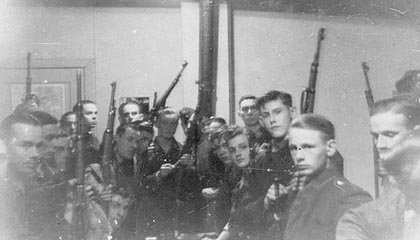 |
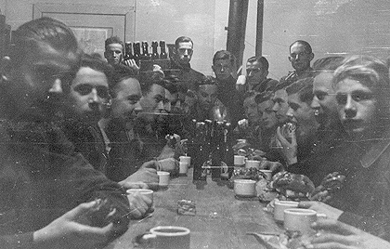 |
|
| |
Two views of 2nd
battalion soldiers in the barracks. Impossible to tell whether this
is Manteuffel or a training area. They strike a pose with rifles
then settle down for the beer.
--Stefanowicz |
|
Motorcycle Battalion #2 was a large unit, the authorized
strength was over 1000 men, divided into three motorcycle
companies, a separate machine gun company, a combat support
company and the headquarters company. Each line company had
fifteen light and medium duty trucks as well as 56 motorcycles
with sidecars. The 207 man unit was supported by 18 medium
machine guns. A company was commanded by a captain, the xo and
one platoon leader were lieutenants. The other two platoons were
led by senior NCOs.
to see the TO & E strength, personnel and equipment, of a
Kradschutzen battalion.
Click here to see the TO & E strength of a typical
Kradschutzen company in the early war years.
The separate machine gun company of the battalion contained
eight additional light machine guns and six 81 mm mortars. The
mortars were probably kept in battery to support the companies,
the machine gun sections might be cross attached as the
situation demanded. The combat support company contained the
supply and maintenance sections, a communications sections as
well as the anti tank platoon and light cannon platoon.
| |
 |
|
| |
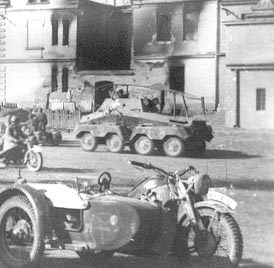 |
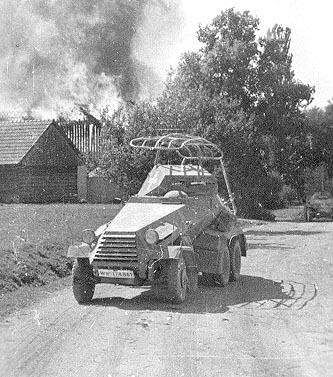 |
|
| |
I have been unable to
find any images of the reconnaissance companies of the 2nd Leichte
Division at Manteuffel. Here is a selection of early war images
showing sample vehicles theunit would have been equipped with. The
metal racks seen reaching over the tops of some of these scout
vehicles are the radio antennas. The images show the dangerous life
that scouts have always faced.
All images : Stefanowicz |
|
The battalion was configured and trained along the new
doctrine of the Schnelle Truppen (fast troops), highly mobile
forces designed to exploit the holes punched by the tank forces.
The motorcycle companies were the first into the gaps to seize
key terrain and hold until relieved by the following truck
mounted infantry. They also could perform reconnaissance
missions and provide flank screens. The Kradschutzen were, like
the US cavalry of decades later, an economy of force unit
capable of a self sustained fight in a fluid environment. On
October 17, 1937, the officers and men of Kradschutzen Battalion
#2 held a parade and open house for the residents of Bad
Kissingen. The following day, the Saale Zeitung, short on detail
but filled with the politically biased writing style of the
period,
reported
on the event.
The man who commanded the battalion in both Eisenach and Bad
Kissingen was a distinguished career officer, Colonel Wilhelm
von Apell. In later assignments, he commanded a Panzer division,
rose to the rank of Lieutenant General and survived the war.
Dates of command and records of the men who commanded the 2
Kradschutzen Battalion may be seen at left.
| |
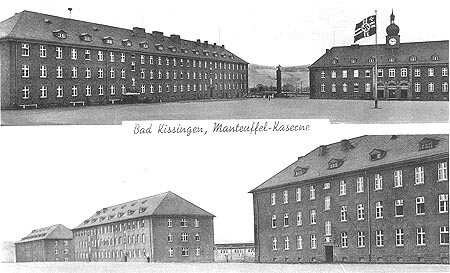 |
|
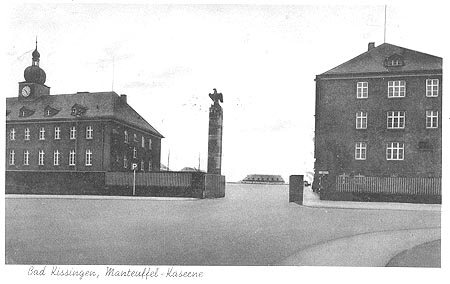 |
|
| |
Period post card with
dual view of Manteuffel Kaserne.
--Stefanowicz |
|
Period post card with
view of front gate to Manteuffel Kaserne.
--Stefanowicz |
|
Less than six months after the open house, the unit deployed
to Austria with the 2nd Panzer Division. War survivors would not
officially return to Bad Kissingen again until the 2 Panzer
Veteran‘s Association reunion was hosted by the town in 1968.
The first military unit assigned to Manteuffel Kaserne had
stayed for less than one year. To learn more about this
movement, their new home and activities of the battalion in
Austria, please follow the link:
Eisenstadt.
The 2 Kradschutzen Battalion would participate in most of the
major German campaigns of World War II including the bloodless
Anschluss ( union ) with Austria, the occupation of
Czechoslovakia, the invasions of Poland, France, Greece and the
Soviet Union. As tactics and the nature of the war evolved, the
2 Krad was merged with the 2nd Panzer Division
reconnaissance battalion while on the Eastern Front. The unit
then saw combat in France following the Normandy landings of the
Allies, Belgium, during the Battle of the Bulge and finally,
Germany, during the defense of the Reich.
| |
 |
|
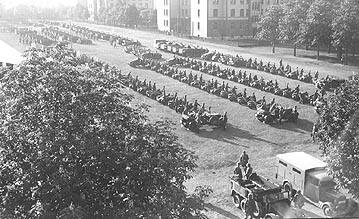 |
|
| |
German war art post
card "Kradschutzen into the fray!!" .
--Stefanowicz |
|
Kradschutzen Battalion
#2 on parade in
Coburg 1937.
--Stefanowicz |
|
The next sixteen months at Manteuffel lack specific detail
but the key facts are known. From the Summer 1938 until August
of 1939, the available documents indicate that the Motorcycle
Infantry Battalion # 1 of the 7th Reconnaissance
Regiment, part of the 2nd Leichte (light) Division was stationed
at Bad Kissingen. This unit had initially been built near the
city of Gera, north of Meiningen, and then moved south to the
now vacant barracks during the hectic days of 1938. A source
briefly also places two armored scout companies from this
regiment’s Battalion # 2 at Manteuffel; the balance of the scout
battalion was based at Meiningen. It was a fast paced and
confusing period.
The 2 Leichte Division took part in the war against Poland in
September 1939 and its Kradschutzen Battalion returned to Bad
Kissingen with a victory parade in October [see section at
left]. To learn more about the
2nd Leichte
Division
and view images related to the period, follow this link.
Of note, the 2 Leichte Division, a pre war configuration of
armor, reconnaissance and infantry units, that had fought with
distinction in Poland was expanded into the 7th Panzer Division
in October 1939. At that point, the motorcycle infantry unit at
Manteuffel Kaserne was redesignated as the 7th Kradschutzen
Battalion. The division left its central Germany garrisons, to
include Bad Kissingen, in January 1940 for camps near the far
western Eifel border region. Erwin Rommel took command of the
7th Panzer on 12 February and that summer, led the division to
victory in France
Commanders of the 2nd Kradschutzen Battalion
(later Reconnaissance Battalion 2)
1936 - 1945 |
| |
Colonel * von Apell
|
1936-1938 |
|
LTC von der Decken |
1938-1939 |
|
LTC Stollbrock |
Feb 39-May 41 |
|
Major Kreuznacher |
May 41- August 42 |
|
Captain Forster |
Aug 42-Sept 42 |
|
Major Petri |
Sept 42-Oct 43 |
|
Major Kuntz |
Oct 43-Jan 44 |
|
Captain Reidel |
Jan 44-May 44 |
|
Captain Schluz |
May 44-June 44 |
|
Major von Schkopp |
June 44-Dec 44 |
|
Major von Laer |
Dec 44-April 45 |
|
Captain Durkes |
April 45-May 45 |
|
* grades are for period in command of 2 Krad / 2 Recon only
and expressed in English |
|
Victory Parade in Bad
Kissingen
Two images showing the victory parade in Bad
Kissingen following the return of the motorcycle infantry
battalion from Poland in late 1939. This unit was part of the 2
Leichte ( light ) Division which was redesignated at the 7th
Panzer Division shortly after these photos were taken. [Photos
courtesy of Norbert Ruckel]
| |
 |
|
 |
|
| |
In late 1939, the 2
Krad is long gone and after the fighting in Poland, the recon BN of
the 7th Recon Regiment, part of the 2nd Light Division (2 Leichte)
parade through Bad Kissingen. |
|
Another
view of the return from Poland parade. |
|
Victory Parade in Meiningen
| |
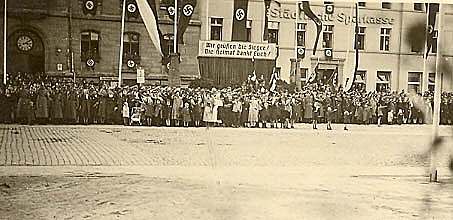 |
|
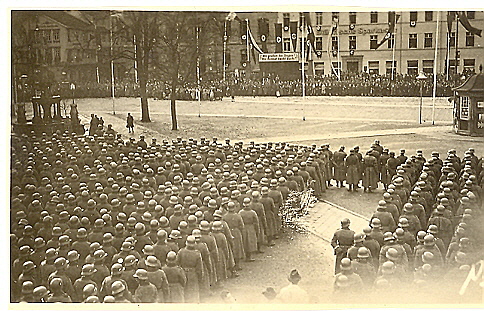 |
|
| |
A rare sequence of photos showing
the victory parade as units of the 2 Leichte Division return to
Meiningen after the defeat of Poland in 1939. The reconnaissance
regiment of the division consisted of two battalions, the motorcycle
infantry unit stationed in Bad Kissingen and the regimental
headquarters and scout battalion located in Meiningen. Seen here,
the central square in Meiningen, the banner sign reads ‘ We greet
the victors - the homeland thanks you! ‘ |
|
A wide view of the scene showing the massed troops. |
|
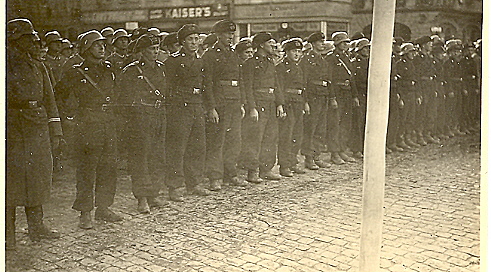 |
|
A close up of the senior NCOs of
the scout battalion in their black Panzer uniforms and padded
berets. Note that the boots are very dusty and no one wears combat
decorations. The parade shows the actual day the unit returned to
garrison after road marching out of Poland.
|
 |
|
The commander of the
reconnaissance regiment leads the parade in his heavy staff car
followed by |
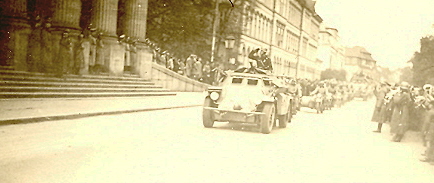 |
|
… the commander of the
scout battalion leading at least a portion of the mechanized unit |
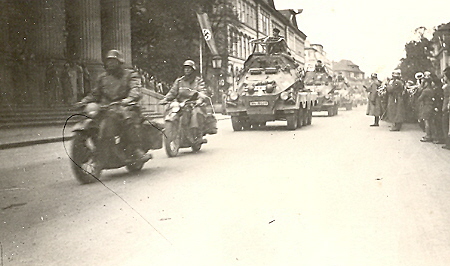 |
|
A military band opposite the
reviewing stand plays martial music as the scout vehicles thunder by
… an impressive collision of traditions.
|
|
|

